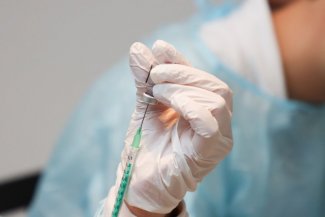Analyses
Problems with the vaccination drive in Ukraine

The situation in mid-September shows that only 12.6% of the population in Ukraine has been fully vaccinated against COVID-19 – the lowest rate in Europe. The declining rate of vaccination matches up with the results of opinion polls. On 13 September, the Democratic Initiatives Foundation published the results of a survey according to which nearly 56.5% of Ukrainians do not plan to take the vaccine. This means that the new wave of infections, which has already started, may be as acute as the previous ones and will probably force the government to reinstate restrictions.
Commentary
- Compared to the EU countries, Ukraine started the vaccination campaign rather late – the first vaccinations did not take place until 24 February. Initially, the vaccination process went very slowly, mainly due to the small number of available vaccines as there was a global shortage of them and the Ministry of Health of Ukraine began the negotiations to buy the vaccines late. As a result, by April Ukraine had only 500,000 AstraZeneca vaccine doses available. Larger supplies followed only at the end of June and the beginning of July, allowing the country to hold a larger-scale vaccination drive. Recently, 22.2 million vaccine doses have been supplied to Ukraine (10.2 million doses of the Chinese Sinovac vaccine, 5 million Pfizer doses, 4.9 million AstraZeneca doses and 2.1 million Moderna doses). The majority of the vaccine doses were funded from the national budget, with the remaining 7.8 million doses supplied as part of the international COVAX programme.
- The Ministry of Health has estimated the overall number of people who need to be vaccinated as a priority at 21 million. At the first stage the vaccination programme was supposed to cover healthcare personnel, at the second stage people over 60 years of age and law enforcement personnel, and at the third stage high risk groups aged from 17 to 60. In reality, since July the vaccines have been available for all those who wished to take them. Despite this, it can be assumed that the government’s vaccination plan would end in failure. Up to 14 September only 4.8 million people in Ukraine have been fully vaccinated, which represents 12.6% of the population. Furthermore, merely 6% of the oldest group (people over 80), who are most at risk of suffering severe symptoms, have been fully vaccinated. Moreover, since mid-August less people have been observed receiving the first dose of the vaccine – at the beginning of August over 500,000 doses were administered weekly; however, at the turn of August and September this was only approximately 300,000 doses weekly.
- A slower pace of vaccination can be observed in most countries. However, in Ukraine this process started relatively quickly. It seems that it is above all due to strong anti-vaxxer sentiments in Ukrainian society, not exclusively linked to COVID-19. In a survey conducted by the Democratic Initiatives Foundation, insufficient testing of the vaccines and concerns related to the side effects were given as the main reasons for not taking the vaccine. Only 23.4% of the respondents were in favour of mandatory vaccination for all citizens over 18 years of age. The Ukrainian government has been running a campaign to promote vaccination but it was not until 13 September that it introduced certain benefits for vaccinated people. All this has been unfolding in the face of a growing number of infections with COVID-19 (since mid-July the average number of infections rose from 500 to 3,000 cases daily) and this makes it more likely that regional lockdowns will be introduced in the coming weeks.
Chart. The percentage of those vaccinated in the countries in the region

Source: compiled by authors based on the data from Our World in Data.




